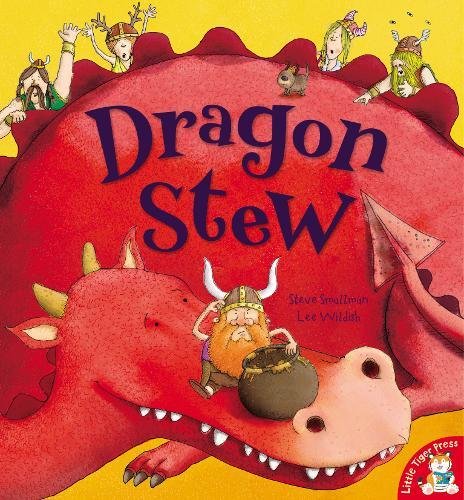This month's Book Nook topic is...
Predicting with Dragon Stew

Reading comprehension is much more than just recognizing the words on a page. It’s about understanding what the words mean and filling in what the writer is “saying” but hasn’t specifically stated. In other words, children must read between the lines to truly understand the book they are reading.
One way to help children look beyond the illustrations and words is to encourage them to use their knowledge and experience to predict what will happen in a story. When children are encouraged to predict what will happen next, they get into the habit of searching for meaning, which is what reading is all about.
Let’s get started!
The Book:
Dragon Stew by Steve Smallman and Lee Wildish
Why we choose it:
This entertaining book is about five bored Vikings who decide to search for a dragon to make dragon stew. There are many opportunities to predict throughout the story as we wonder where they will find the dragon, and what will happen when they finally meet him.
Help your child predict:
The first time you read a story is an excellent opportunity to predict, because your child does not yet know the answer. Predicting is not about being right or wrong – it’s about thinking about what might happen. Once your child has heard a story, you can still predict by thinking about what happens to the characters after the story is finished.
You can encourage your child to predict by:
- Making “thinking-out-loud” comments
- Asking questions that build understanding
Thinking-out-loud comments show your child that you are thinking about the story and trying to figure out what might happen next.
Thinking-out-loud comments start with words like:
- “I’m thinking that…”
- “I’m wondering about…”
- “I’m trying to figure out…”
Unlike questions, comments don’t require a response. However, if you make a comment and then wait, chances are your child will want to respond to your comment!
You can also encourage your child to make predictions by asking questions like:
- What do you think the Vikings could do since they are bored?
- Do you think the Vikings are going to find the dragon?
- What do you think will happen when the Vikings catch the dragon?
If your child has difficulty answering these questions, just provide your own answer and keep reading.
Get your child predicting before you start reading:
Before you read this book for the first time, look at the cover with your child and encourage him to predict what the story will be about. When talking about the cover of Dragon Stew which shows a picture of the Vikings sitting on a large red dragon, you could say, “This story is called Dragon Stew. I’m thinking that the Vikings are going to have trouble capturing such a huge dragon. What do you think?” Then you could wait to see if your child responds to your question. Once your child responds, you could say, “Maybe. Let’s read the book and find out.”
Help your child predicting after you finish reading:
During the first reading, make comments or ask questions about what’s happening, and what will happen next. For example, if your child likes the page where the Vikings are on their boat:
- “I wonder if the whale will tell them how to find the dragon.”
Or you could ask:
- “Do you think the whale knows where the dragon lives?”
Keep your child predicting after you finish reading:
When you finish reading the book with your child, you can continue to predict by asking questions and making comments about what might happen after the story ends.
For example, you might make a thinking-out-loud comment like, “I’m thinking that the dragon is going to go back to sleep now that he got rid of the Vikings,” or ask a question like, “What do you think the Vikings will do now?”
Encouraging your child to think about what might happen after the story ends is one way to keep predicting even after he already knows the whole story.
Happy reading!
More Resources
The strategies in this Book Nook post are drawn from Hanen’s practical, research-based guidebooks for building emergent literacy. Explore the links below to learn more about how these guidebooks can support you.
For Parents I'm Ready! guidebook
I'm Ready! guidebook
For Educators ABC and Beyond guidebook
ABC and Beyond guidebook
